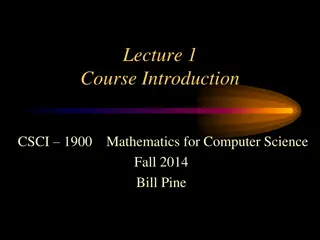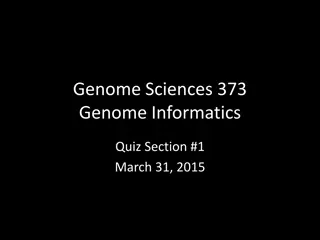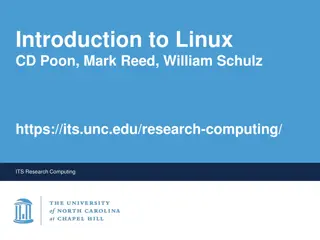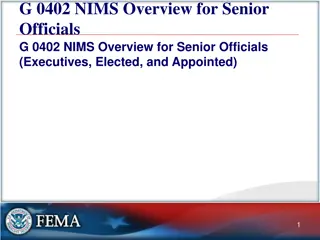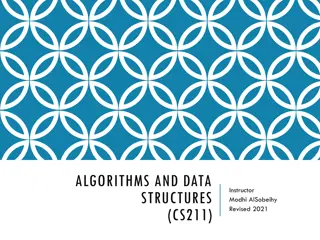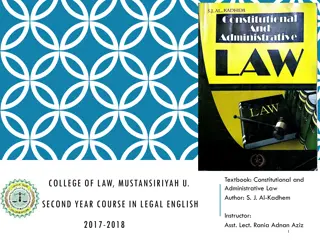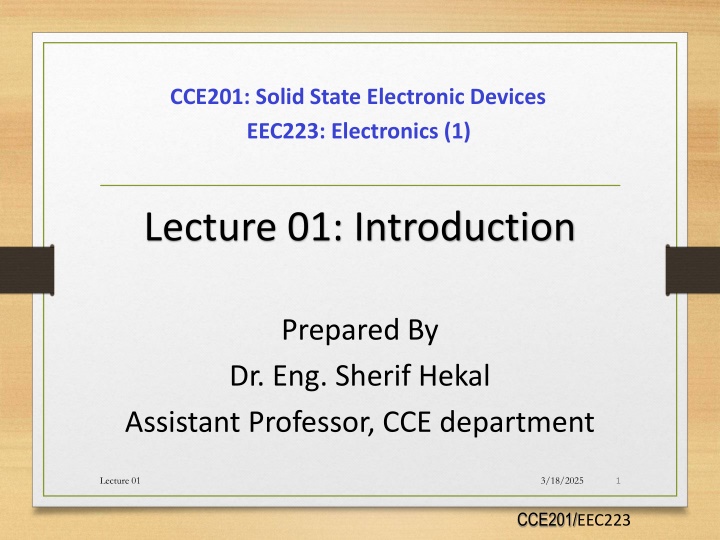
Solid State Electronic Devices Course Information
Explore the course information for CCE201/EEC223 covering topics like semiconductor physics, diode characteristics, transistor operations, and more. Meet the teaching staff and find contact details for Dr. Sherif Hekal. Discover the course meeting times and locations for lectures, tutorials, and labs. Remember to abide by the course rules during sessions.
Uploaded on | 0 Views
Download Presentation

Please find below an Image/Link to download the presentation.
The content on the website is provided AS IS for your information and personal use only. It may not be sold, licensed, or shared on other websites without obtaining consent from the author. If you encounter any issues during the download, it is possible that the publisher has removed the file from their server.
You are allowed to download the files provided on this website for personal or commercial use, subject to the condition that they are used lawfully. All files are the property of their respective owners.
The content on the website is provided AS IS for your information and personal use only. It may not be sold, licensed, or shared on other websites without obtaining consent from the author.
E N D
Presentation Transcript
CCE201: Solid State Electronic Devices EEC223: Electronics (1) Lecture 01: Introduction Prepared By Dr. Eng. Sherif Hekal Assistant Professor, CCE department Lecture 01 3/18/2025 1 CCE201/EEC223
Course Information 1 Course Name:Solid State Electronic Devices Course Code: CCE201 Course Materials are on my website: http://www.bu.edu.eg/staff/sherifsalah3 3/18/2025 2 CCE201/EEC223
Course Information 2 Course Name:Electronics (1) Course Code: EEC223 Course Materials are on my website: http://www.bu.edu.eg/staff/sherifsalah3 3/18/2025 3 CCE201/EEC223
Teaching staff Lecturers Prof. Hala Abdel-Kader Assistant Prof. Sherif Hekal Teaching Assistant Eng. Ahmed Samir Lecture 01 3/18/2025 4 CCE201/EEC223
Contact me Dr. Sherif Hekal Room number : SB5-05 Email address: Sherif.salah@feng.bu.edu.eg Lecture 01 3/18/2025 5 CCE201/EEC223
My rules No eating No drinking Silence except for asking questions Shutdown your Mobile, Tablet, etc. and put in your pocket. 3/18/2025 6 CCE201/EEC223
Course meeting time & Location Number / week Day Time Location Saturday 09:00-11:00 Room ?? lectures 2 h Contact Saturday 11:00-13:00 Room ?? tutorial 2 h hours Tuesday 13:00-16:00 Electronics Lab Lab* 3 h * Lab times are only for the students of Electronics (1) course Lecture 01 3/18/2025 7 CCE201/EEC223
CCE201: Course Info Course Title Solid State Electronic Devices Course Code CCE201 Credit Hours 3 Contact Hours Lecture 2 Tutorials 2 Lab. - Prerequisite(s) EMP104 Topics Basics of semiconductor physics Fermi-Dirac distribution Carriers concentrations Intrinsic and Extrinsic materials Charge neutrality Currents in Semiconductors (drift current diffusion current) Semiconductor parameters (mobility, Scattering, lifetime) Hall effect. PN junction theory Diode IV characteristics large and small analysis Analog and digital diode applications (Rectifiers, Clipping circuits, Clamping Circuits, multipliers) Special purpose diodes (Light emitting diodes, photo diodes, Zener diode and its applications) Basics of Bipolar junction transistors (BJT) and field effect transistors (FET) physical operations, characteristics, specifications. Lecture 01 3/18/2025 8 CCE201/EEC223
EEC223: Course Info Course Title Electronics (1) Course code EEC223 Credit hours 4 Contact Hours Lectures 2 Tutorials 2 Lab. 3 Prerequisites EEC211 Topics Semiconductors, p-n junction, diode current components, junction capacitance, junction diode as a circuit element, special p-n junctions, bipolar junction transistor and field effect transistor, Thyristors. Lecture 01 3/18/2025 9 CCE201/EEC223
Course Assessment Assessment Type Time Percentage Midterm1 30% Week 07 Midterm2 20% Week 12 Attendance, Assignments 10% Final Exam 40% Week 16 Total mark 100% Conditions of the success are: 1- getting 60% of the total mark. 2- getting at least 30% of the full mark of the final exam. Lecture 01 3/18/2025 10 CCE201/EEC223
Course Assessment Percentage Grade A+ A A- B+ B B- C+ C C- D+ D F Points 4 4 3.7 3.3 3 2.7 2.3 2 1.7 1.3 1 0 Score 97% 93% Score < 97% 89% Score < 93% 84% Score < 89% 80% Score < 84% 76% Score < 80% 73% Score < 76% 70% Score < 73% 67% Score < 70% 64% Score < 67% 60% Score < 64% Score < 60% Lecture 01 3/18/2025 11 CCE201/EEC223
Syllabus Weeks Topics 1 2 3 4 5 6 7 8 9 10 11 12 13 14 15 Introduction Basics of semiconductor physics Intrinsic & Extrinsic semiconductors Carrier Transfer PN-junction PN-diodes and their applications Midterm 1 Special purpose diodes Bipolar junction transistor (BJT) I Bipolar junction transistor (BJT) II Bipolar junction transistor (BJT) III Midterm 2 FET transistor I FET transistor II Thyristors Lecture 01 3/18/2025 12 CCE201/EEC223
Syllabus Text Book S. M. Sze (2001). Semiconductor Devices: Physics and Technology, Wiley & So., ISBN 0471333727. Recommended references supporting the course B. Streetman, S. Banerjee (1999).Solid State Electronic Devices, Prentice Hall, ISBN 0130255386. Robert L. Boylestad, Louis Nashelsky, (2013) Electronic devices and circuit theory, 11th edition, Pearson Education Neamen D.A., (2007), Microelectronics Circuit Analysis and Design, McGraw Hill. Lecture 01 3/18/2025 13 CCE201/EEC223
Simulators Proteus OrCAD SPICE Online simulator http://www.falstad.com/circuit/index.html Lecture 01 3/18/2025 14 CCE201/EEC223
ILOS Theory Analysis Simulation Implementation Lecture 01 3/18/2025 15 CCE201/EEC223
ILOS Upon successful completion of the course, students will be able to: Acquire some understanding in the fundamental electric and electronics principles. Describe the operation and i-v characteristics of diodes and transistors. Solve basic problems in electronic circuits. Implement different applications using basic electronic devices (diodes and transistors). Read and understand the datasheets of diodes and transistors to use the suitable parts in design. Design and analyze electronic circuits use computer packages (simulators). Acquire better skills in performing the laboratory experiments. Work as a team in laboratory sessions. Lecture 01 3/18/2025 16 CCE201/EEC223
Course Objectives Identify and describe operation of semiconductor devices through understanding of the semiconductor physics. Develop an understanding of the PN junction diode and its behavior. Develop an ability to analyze diode circuits and examine additional applications of the diode. Develop an understanding of the Bipolar Junction Transistor (BJT) and its operation. Identify and describe the different BJT configurations, DC biasing, and AC analysis. Develop an understanding of the Field Effect Transistor (FET) and its operation. Identify and describe the different FET configurations, DC biasing, and AC analysis. Develop an ability to analyze and design BJT and FET circuits. Lecture 01 3/18/2025 17 CCE201/EEC223
Course Objectives Lecture 01 3/18/2025 18 CCE201/EEC223
Course Objectives Lecture 01 3/18/2025 19 CCE201/EEC223
Course Objectives Lecture 01 3/18/2025 20 CCE201/EEC223
Course Objectives Lecture 01 3/18/2025 21 CCE201/EEC223
Example of Questions State two (2) differences between FET and BJT LEVEL 1 Explain how depletion region is created in a pn junction? LEVEL 2 Lecture 01 3/18/2025 22 CCE201/EEC223
Example of Questions Sketch the output voltage, VO if the input signal, Vi is a 12 V peak-to-peak square wave LEVEL 3 Analyze the circuit below to calculate the base, collector and emitter currents LEVEL 4 Lecture 01 3/18/2025 23 CCE201/EEC223
Example of Questions Compare the two characteristics for a conventional pn-junction diode and a Zener diode LEVEL 4/5 Evaluate the circuit below to determine whether the BJT is in cut-off, active or saturation mode LEVEL 5 Lecture 01 3/18/2025 24 CCE201/EEC223
Example of Questions Design an n-channel MOSFET circuit is as shown in the figure - LEVEL 6 NOTE: A DESIGN question generally means that you are required to calculate the values of the resistors. Lecture 01 3/18/2025 25 CCE201/EEC223






